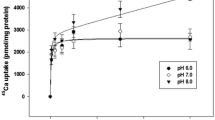Summary
Transport by an epithelium, possessing an accumulating, saturable transport system in the apical membrane as well as a finite Fick permeability to the transported solute, was considered in the steady state in the case of zerocis concentration, and in the presence of a peripheral diffusion resistance in a layer apposing thecis face of the tissue (unstirred solution or structural coating). Under suitable conditions, the combination of peripheral diffusion resistance and accumulating epithelial transport may lead to recycling of solute at thecis face of the epithelium. This causes a decrease of the effective permeability to diffusionaltrans-cis flow across the tissue. The phenomenon is discussed in terms of epidermald-glucose transport by the integument of aquatic animals with a collagenous cuticle, such as the seawater-acclimated polychaete wormNereis diversicolor. The recycling phenomenon may be of significance to other epithelia with the function of maintaining large concentration gradients of permeating substances.
Similar content being viewed by others
Abbreviations
- C m :
-
Bulk medium solute concentration,cis face of epidermisC m=0 mol cm−3
- C i :
-
Concentration of solute at interface between cuticle and unstirred medium (mol cm−3)
- C s :
-
Concentration of solute atcis face of apical epidermal membrane (mol cm−3)
- C e :
-
Concentration of solute in extracellular fluid,trans-side of epidermisC e=1.0×10−6 mol cm−3
- D m :
-
Diffusion coefficient of solute in outside mediumD m=6.7×10−6 cm2 sec−1
- D c :
-
Diffusion coefficient of solute in cuticleD c=7.4×10−9 cm2 sec−1
- δ m :
-
Operative thickness of unstirred medium layer
- δ c :
-
Thickness of cuticle
- J :
-
Steady-state net flux of solute through cuticle or unstirred layer (flux is positive indirectioncis-trans) (mol cm−2 sec−1)
- J max i :
-
Maximal influx through saturable transport system in apical membraneJ max i =2.0×10−12 mol cm−2 sec−1
- K t :
-
Transport constant, saturable systemK t=1.0×10−7 mol cm−3
- P :
-
Epithelial permeability (cm sec−1)
References
Altman, P.L., Dittmer, D.S. 1972. Biology Data Book. Vol. I, 2nd ed. Federation of American Societies for Experimental Biology, Bethesda, Maryland
Bird, A.F. 1957. Chemical composition of the nematode cuticle. Observations on individual layers and extracts from these layers inAscaris lumbricoides cuticle.Exp. Parasitol. 6:383–403
Bird, A.F. 1971. The structure of nematodes. Ch. 3. Academic Press, New York
Brown, S.C., McGee-Russell, S. 1971.Chaetopterus tubes. Ultrastructural architecture.Tissue Cell 3:65–70
Castro, G.A., Fairbairn, D. 1969. Comparison of cuticular and intestinal absorption ofd-glucose by adultAscaris lumbricoides.J. Parasitol. 55:13–16
Christensen, H.N. 1975. Biological Transport. Benjamin, Reading, Mass.
Dainty, J., House, C.R. 1966. ‘Unstirred layers’ in frog skin.J. Physiol. (London) 182:66–78
Gomme, J. 1981a.d-glucose transport across the apical membrane of the surface epithelium inNereis diversicolor.J. Membrane Biol. 62:29–46
Gomme, J. 1981b. Epidermal nutrient absorption in marine invertebrates: A comparative analysis.Am. Zool. (in press)
Jørgensen, C.B. 1976. August Pütter, August Krogh, and modern ideas on the use of dissolved organic matter in aquatic environments.Biol. Rev. 51:291–329
Lee, D.L., Atkinson, H.J. 1976. The Physiology of Nematodes. McMillan Press, London
Sepers, A.B.J. 1977. The utilization of dissolved organic compounds in aquatic environments.Hydrobiologica 52:39–54
Stephens, G.C. 1967. Dissolved organic material as a nutritional source for marine and estuarine invertebrates.In: Estuaries. G.H. Lauff, editor. pp. 367–373. American Association for the Advancement of Science, Washington
Stephens, G.C. 1972. Amino acid accumulation and assimilation in marine organisms.In: Nitrogen Metabolism and the Environment. J.W. Campbell and L. Goldstein, editors. pp. 155–184. Academic Press, New York
Stewart, M.G. 1979. Absorption of dissolved organic nutrients by marine invertebrates.Oceanogr. Mar. Biol. Annu. Rev. 17:163–192
Wang, J.H., Robinson, C.V., Edelman, I.S. 1953. Self-diffusion and structure of liquid water. III. Measurement of self-diffusion of liquid water with H2, H3, and O18 as tracers.J. Am. Chem. Soc. 75:466
Weast, R.C. 1969. Handbook of Chemistry and Physics, 50th ed. The Chemical Rubber Co., Cleveland, Ohio
Author information
Authors and Affiliations
Rights and permissions
About this article
Cite this article
Gomme, J. Recycling ofd-glucose in collagenous cuticle: A means of nutrient conservation?. J. Membrain Biol. 62, 47–52 (1981). https://doi.org/10.1007/BF01870198
Received:
Revised:
Issue Date:
DOI: https://doi.org/10.1007/BF01870198




